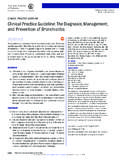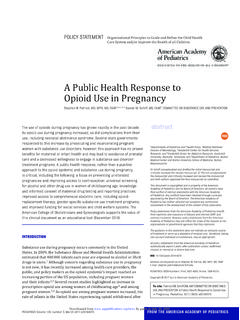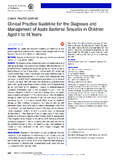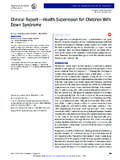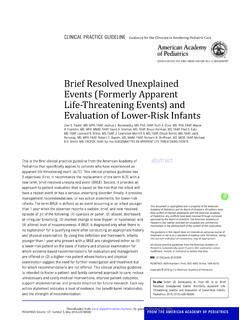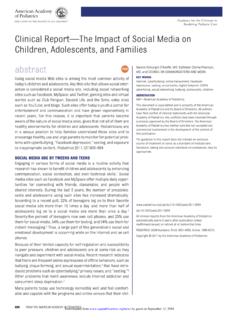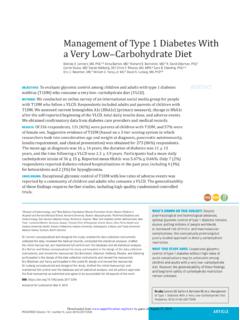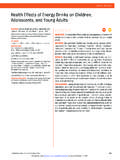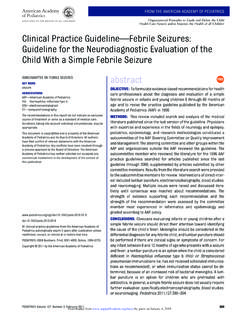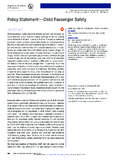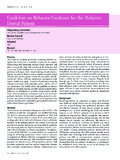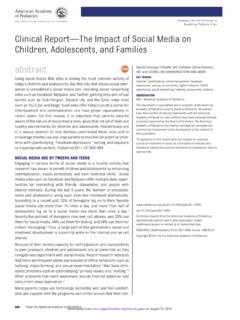Transcription of CLINICAL PRACTICE GUIDELINE ADHD: Clinical …
1 FROM THE AMERICAN ACADEMY OF PEDIATRICS. Guidance for the Clinician in Rendering Pediatric Care CLINICAL PRACTICE GUIDELINE . ADHD: CLINICAL PRACTICE GUIDELINE for the Diagnosis, Evaluation, and Treatment of Attention-De cit/. Hyperactivity Disorder in Children and Adolescents SUBCOMMITTEE ON ATTENTION-DEFICIT/HYPERACTIVITY. DISORDER, STEERING COMMITTEE ON QUALITY. IMPROVEMENT AND MANAGEMENT. abstract +. KEY WORDS. Attention-de cit/hyperactivity disorder (ADHD) is the most common attention-de cit/hyperactivity disorder, children, adolescents, neurobehavioral disorder of childhood and can profoundly affect the preschool, behavioral therapy, medication academic achievement, well-being, and social interactions of children;. ABBREVIATIONS the American Academy of Pediatrics rst published CLINICAL recommen- AAP American Academy of Pediatrics ADHD attention-de cit/hyperactivity disorder dations for the diagnosis and evaluation of ADHD in children in 2000;. DSM-PC Diagnostic and Statistical Manual for Primary Care recommendations for treatment followed in 2001.
2 Pediatrics 2011;128: CDC Centers for Disease Control and Prevention 000. FDA Food and Drug Administration DSM-IV Diagnostic and Statistical Manual of Mental Disorders, Fourth Edition MTA Multimodal Therapy of ADHD Summary of key action statements: This document is copyrighted and is property of the American 1. The primary care clinician should initiate an evaluation for ADHD for Academy of Pediatrics and its Board of Directors. All authors any child 4 through 18 years of age who presents with academic or have led con ict of interest statements with the American Academy of Pediatrics. Any con icts have been resolved through behavioral problems and symptoms of inattention, hyperactivity, or a process approved by the Board of Directors. The American impulsivity (quality of evidence B/strong recommendation). Academy of Pediatrics has neither solicited nor accepted any commercial involvement in the development of the content of 2. To make a diagnosis of ADHD, the primary care clinician should this publication.
3 Determine that Diagnostic and Statistical Manual of Mental Disor- The recommendations in this report do not indicate an exclusive ders, Fourth Edition criteria have been met (including documenta- course of treatment or serve as a standard of medical care. tion of impairment in more than 1 major setting); information Variations, taking into account individual circumstances, may be appropriate. should be obtained primarily from reports from parents or guard- ians, teachers, and other school and mental health clinicians in- volved in the child's care. The primary care clinician should also rule out any alternative cause (quality of evidence B/strong recommendation). 3. In the evaluation of a child for ADHD, the primary care clinician should include assessment for other conditions that might coexist with ADHD, including emotional or behavioral (eg, anxiety, depres- sive, oppositional de ant, and conduct disorders), developmental (eg, learning and language disorders or other neurodevelopmental disorders), and physical (eg, tics, sleep apnea) conditions (quality of evidence B/strong recommendation).
4 All CLINICAL PRACTICE guidelines from the American Academy of Pediatrics automatically expire 5 years after publication unless 4. The primary care clinician should recognize ADHD as a chronic reaf rmed, revised, or retired at or before that time. condition and, therefore, consider children and adolescents PEDIATRICS (ISSN Numbers: Print, 0031-4005; Online, 1098-4275). with ADHD as children and youth with special health care needs. Copyright 2011 by the American Academy of Pediatrics Management of children and youth with special health care needs should follow the principles of the chronic care model and the medical home (quality of evidence B/strong recommendation). PEDIATRICS Volume 128, Number 5, November 2011 1. Downloaded from by guest on January 31, 2018. 5. Recommendations for treatment of should prescribe Food and dren 6 through 12 years of age. There children and youth with ADHD vary Drug Administration approved is now emerging evidence to expand depending on the patient's age: medications for ADHD with the the age range of the recommendations a.
5 For preschool-aged children assent of the adolescent (qual- to include preschool-aged children (4 5 years of age), the primary ity of evidence A/strong recom- and adolescents. This GUIDELINE ad- care clinician should prescribe mendation) and may prescribe dresses the diagnosis and treatment evidence-based parent- and/or behavior therapy as treatment of ADHD in children 4 through 18 years teacher-administered behavior for ADHD (quality of evidence of age, and attention is brought to spe- therapy as the rst line of treat- C/recommendation), preferably cial circumstances or concerns in par- ment (quality of evidence both. ticular age groups when appropriate. A/strong recommendation) and 6. The primary care clinician should Expanded Scope may prescribe methylphenidate titrate doses of medication for if the behavior interventions do ADHD to achieve maximum bene t Behavioral interventions might help not provide signi cant improve- with minimum adverse effects families of children with hyperactive/.
6 Ment and there is moderate-to- (quality of evidence B/strong impulsive behaviors that do not meet severe continuing disturbance recommendation). full diagnostic criteria for ADHD. Guid- in the child's function. In areas ance regarding the diagnosis of where evidence-based behav- INTRODUCTION problem-level concerns in children ioral treatments are not avail- based on the Diagnostic and Statisti- This document updates and replaces 2. able, the clinician needs to cal Manual for Primary Care (DSM-PC), previously published CLINICAL guide- weigh the risks of starting med- Child and Adolescent Version,3 as well lines from the American Academy of ication at an early age against as suggestions for treatment and care Pediatrics (AAP) on the diagnosis and of children and families with problem- the harm of delaying diagnosis treatment of attention-de cit/hyperac- and treatment (quality of evi- level concerns, are provided here. The tivity disorder (ADHD) in children: current DSM-PC was published in 1996.)
7 Dence B/recommendation). CLINICAL PRACTICE GUIDELINE : Diagnosis and, therefore, is not consistent with b. For elementary school aged and Evaluation of the Child With Atten- intervening changes to International children (6 11 years of age), the tion-De cit/Hyperactivity Disorder Classi cation of Diseases, Ninth Revi- primary care clinician should (2000)1 and CLINICAL PRACTICE Guide- sion, CLINICAL Modi cation (ICD-9-CM). prescribe US Food and Drug line: Treatment of the School-aged Although this version of the DSM-PC. Administration approved medica- Child With Attention-De cit/Hyperactiv- should not be used as a de nitive tions for ADHD (quality of evi- ity Disorder (2001).2 Since these source for diagnostic codes related to dence A/strong recommendation) guidelines were published, new infor- ADHD and comorbid conditions, it cer- and/or evidence-based parent- mation and evidence regarding the di- tainly may continue to be used as a and/or teacher-administered agnosis and treatment of ADHD has be- resource for enriching the under- behavior therapy as treatment come available.
8 Surveys conducted standing of ADHD manifestations. The for ADHD, preferably both (qual- before and after the publication of the DSM-PC will be revised when both the ity of evidence B/strong recom- previous guidelines have also provided DSM-V and ICD-10 are available for use. mendation). The evidence is par- insight into pediatricians' attitudes ticularly strong for stimulant and practices regarding ADHD. On the A Process of Care for Diagnosis medications and suf cient but basis of an increased understanding and Treatment less strong for atomoxetine, regarding ADHD and the challenges it This GUIDELINE and process-of-care al- extended-release guanfacine, raises for children and families and as gorithm (see Supplemental Fig 2 and and extended-release clonidine a source for clinicians seeking to diag- Supplemental Appendix) recognizes (in that order) (quality of evi- nose and treat children, this GUIDELINE evaluation, diagnosis, and treatment dence A/strong recommenda- pays particular attention to a number as a continuous process and provides tion).
9 The school environment, of areas. recommendations for both the guide- program, or placement is a part line and the algorithm in this single of any treatment plan. Expanded Age Range publication. In addition to the formal c. For adolescents (12 18 years of The previous guidelines addressed di- recommendations for assessment, di- age), the primary care clinician agnosis and treatment of ADHD in chil- agnosis, and treatment, this GUIDELINE 2 FROM THE AMERICAN ACADEMY OF PEDIATRICS. Downloaded from by guest on January 31, 2018. FROM THE AMERICAN ACADEMY OF PEDIATRICS. provides a single algorithm to guide are beyond the scope of this GUIDELINE the AAP, CDC, and University of Okla- the CLINICAL process. but are important to consider. homa Health Sciences Center staff. The treatment-related evidence relied on a Integration With the Task Force on METHODOLOGY recent evidence review by the Agency Mental Health As with the 2 previously published clin- for Healthcare Research and Quality This GUIDELINE ts into the broader ical guidelines , the AAP collaborated and was supplemented by evidence mission of the AAP Task Force on with several organizations to develop a identi ed through the CDC review.
10 Mental Health and its efforts to pro- working subcommittee that repre- The diagnostic issues were focused on vide a base from which primary care sented a wide range of primary care 5 areas: providers can develop alliances with and subspecialty groups. The subcom- 1. ADHD prevalence speci cally: (a). families, work to prevent mental mittee included primary care pediatri- What percentage of the general US. health conditions and identify them cians, developmental-behavioral pedi- population aged 21 years or early, and collaborate with mental atricians, and representatives from younger has ADHD? (b) What per- health clinicians. the American Academy of Child and Ad- centage of patients presenting at The diagnosis and management of olescent Psychiatry, the Child Neurol- pediatricians' or family physicians'. ADHD in children and youth has been ogy Society, the Society for Pediatric of ces in the United States meet di- particularly challenging for primary Psychology, the National Association of agnostic criteria for ADHD?
